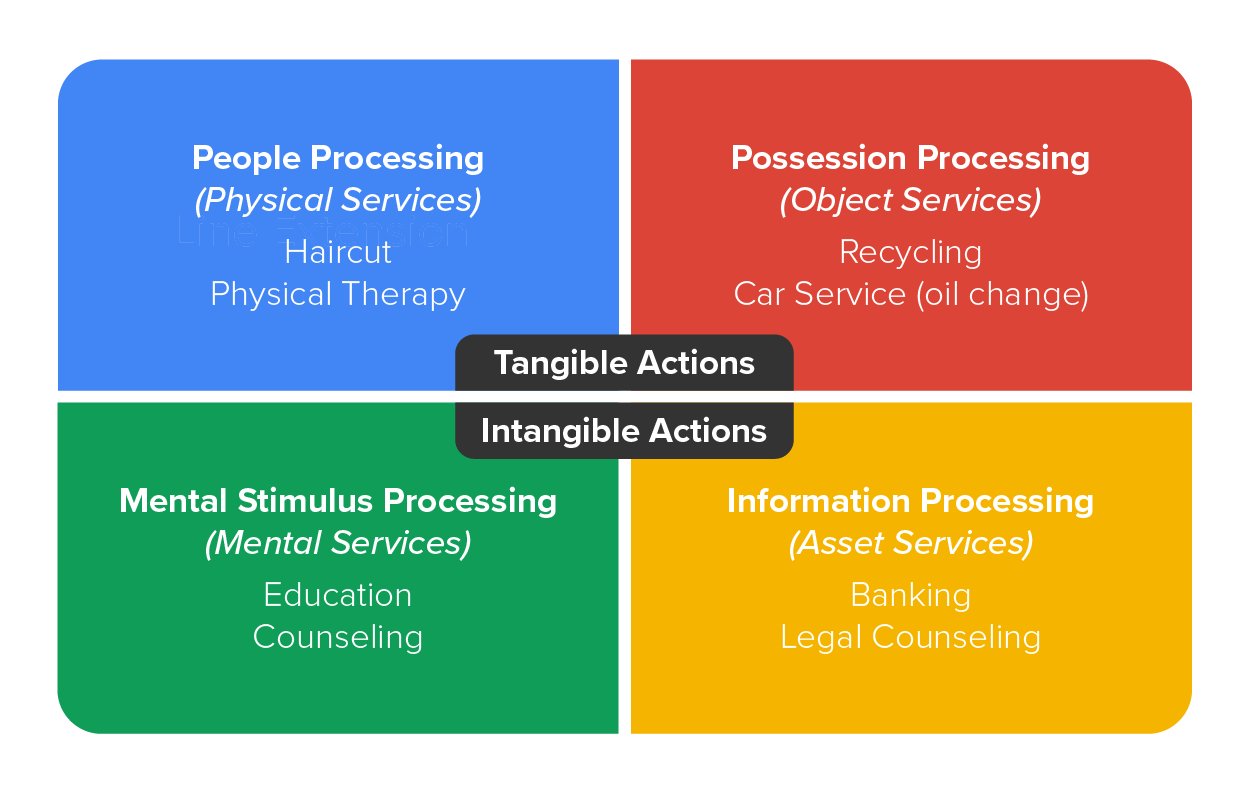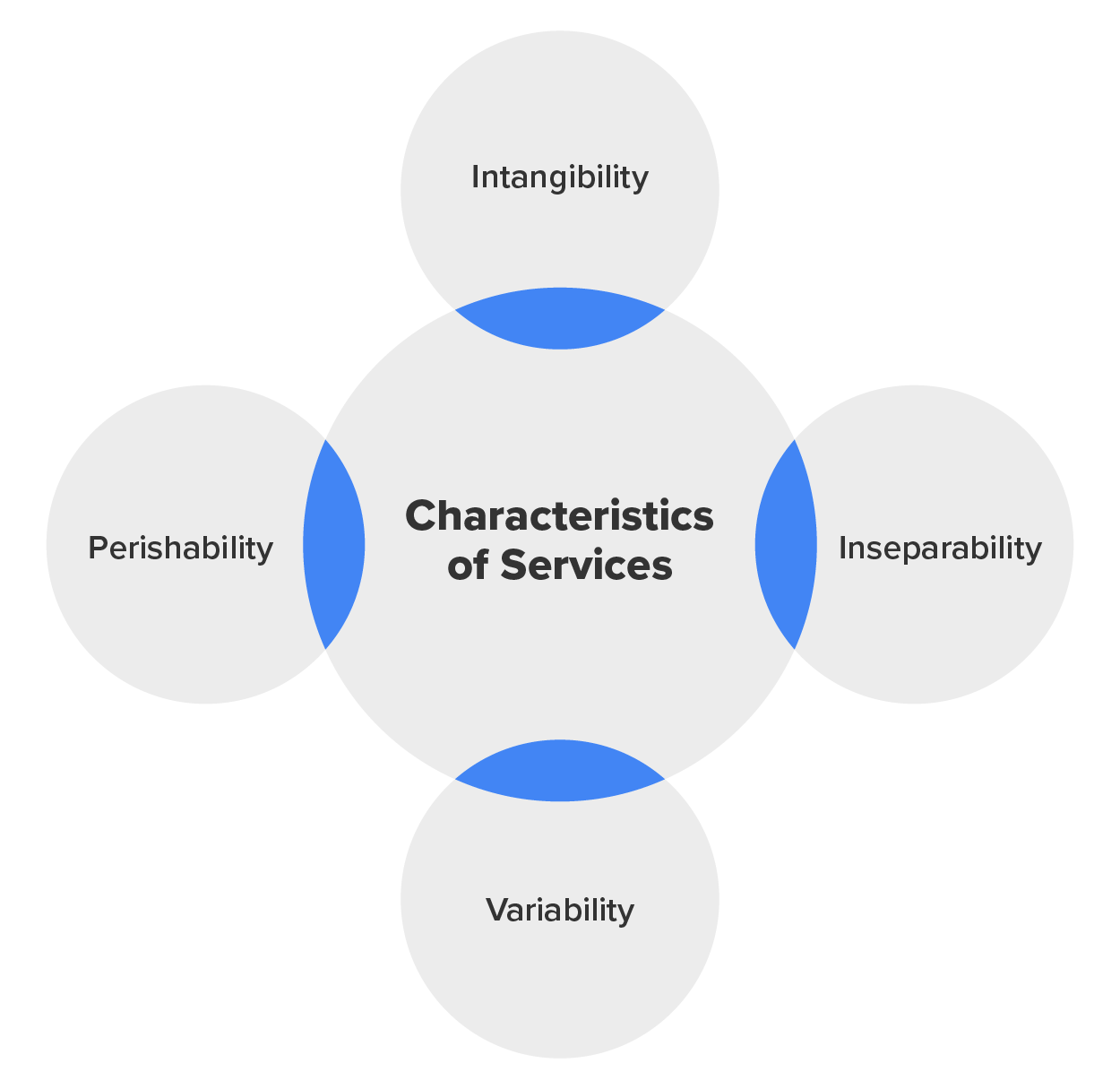Table of Contents |
Services are intangible solutions that are also an exchange between buyer and seller. Unlike products, services cannot be touched, owned, or stored for later use. For example, a college course on marketing is a service. Students cannot own the course; they cannot store it for later, nor will they have a tangible object representing the course. Another defining feature of a service is the customer is typically a part of the service experience. Imagine buying tickets to your favorite band in concert. You will have to attend the concert to realize the full benefit of the service experience. Both products and services are considered on a continuum.

Customer experience (CX) is the overarching impression that customers have of a brand. Therefore, each touchpoint with a product or service becomes a part of the customer experience. A strong customer experience integrates technology, marketing, sales, and customer service to deliver a strong brand perception.
EXAMPLE
If you have ever visited an Apple Store, you probably have experienced one of the most lauded customer experiences there is. From the moment you walk in, you are surrounded by products and transported into a world of technology. Each touchpoint, from the check-in on an iPad to the latest products that are available for use, reinforces the brand through customer experience. Brands with strong customer experience tend to have more loyal customers who become brand advocates.There are four main types of service experiences, according to well-known author and professor Christopher Lovelock (1940–2008): physical, object, mental, and asset services.

IN CONTEXT
In physical services, the customer is a direct recipient of the service, and the production and consumption of the service are simultaneous. Consider examples of services where you must be present in the service facility in order to interact with the service provider and receive the service, such as barbershops or hair salons, physical therapists’ offices, or restaurants.
Object services are directed toward the customer’s physical possessions. In other words, production and consumption are separate. Your only involvement is dropping off the item that requires service or repair and explaining the problem. For example, once you have taken your car in for an oil change, you do not need to be physically at the location for the oil change to occur. Similarly, once you’ve dropped your clothes off at the dry cleaners, you don’t need to be physically present when the cleaning process is performed. These services are tangible because the direct recipient is one of your possessions rather than you as a person.
In its simplest explanation, mental services interact with your mind rather than your body. Time and mental effort are required from the customer to receive this type of service. What you’re doing right now—reading this textbook—is a prime example of mental stimulus processing. Other examples include psychotherapy or counseling services. The key here is that services rendered in this category are intangible.
Asset services are the most intangible form of services, although they can be transformed into a tangible service output like reports, books, letters, DVDs, etc. Some examples of information processing services are things like meeting with your financial advisor regarding investment advice, legal services, and banking.
As we pointed out above, some services come from physical products, such as getting a haircut or having your income tax return prepared by a professional. But other services are completely intangible. When you rent a hotel room, travel on an airplane, visit your doctor, attend a professional sporting event, or get advice from a lawyer or an accountant, you’re buying a service, so a marketer needs to consider the characteristics of services in order to get the right marketing messages to the right target market.

By their very nature, services are intangible, which means they can’t be seen, tasted, felt, smelled, or heard before they are purchased. Consider the last time you purchased automobile insurance for your car. Other than the physical policy the company sends you (the only tangible asset), what you’ve paid for is completely intangible—it’s the company’s promise to pay claims against the policy. Intangible services have a number of implications in marketing. The very fact that there’s nothing to touch, hear, smell, and so on typically increases the level of uncertainty that a consumer faces when choosing between services offered by your organization or those of competitors. Intangible services can seldom be tried out, inspected, or even given a “test drive” by a customer. Customers have to rely on the word of the marketers in order to assess what they’re actually going to get in return for what they’ve paid. In effect, they are buying a promise. Savvy marketers reduce this uncertainty by creating physical “evidence” that allows the consumer to picture the service before it is purchased.
EXAMPLE
A hair salon may have imaging software that predicts how you would look with different hairstyles or colors. Companies like Zenni and Eyebuydirect have a virtual mirror that allows you to “try on eyeglasses” and see how the selected frames look on your face before you purchase.Services are inseparable from their production and consumption meaning that they are produced and consumed simultaneously. The order of production and consumption between a physical product and a service differs. Think about a box of Girl Scout cookies, a physical good or product. The cookies were produced, stored, sold, and finally consumed. That’s not the way it works with services. For example, try to get money out of your bank on a weekend or evening without an ATM, or try to get a haircut without the physical presence of your stylist. That’s the concept of service inseparability—you can’t separate the delivery of the service from the presence of the customer. In other words, the service provider is physically connected to the service and is evaluated on the basis of their communication skills, language, demeanor, personal hygiene, and clothing. The impact to the marketer in these services—in which the service provider and customer must both be present—is how service providers (sometimes called frontline employees) conduct themselves in the presence of the customer because it may determine the likelihood of repeat business. There are also other marketing implications with this concept, such as customer cooperation and participation, not to mention the influence from other customers who may be present.
Service involves variability—the quality of the service depends on who provides it, when it is provided, and how it is provided.
You were seated promptly by a cheerful hostess; the busser filled up your water glass and refilled it several times during the evening; the waitstaff was attentive but not to the point of being annoying; and your dirty dishes were cleared promptly. But perhaps the next time you visit the same restaurant, your experience isn’t quite as amazing. The hostess isn’t as cheerful, and it takes her several minutes to seat you. It takes a while for someone to refill your water glass. The waitstaff isn’t nearly as attentive as they were during your first visit. What went wrong? For example, Delta Air Lines prides itself on improving peoples’ lives and exceeding customer expectations. However, because services are provided by humans who have human experiences where they may not be feeling well or they are having a bad day, the service may be variable between employees. One Delta employee may be cheerful and efficient, while another lags due to their energy and state of mind. This is a challenge to marketers because products generally have little variability: each unit is built to certain specifications. If you buy an Apple iPad Pro and your classmate purchases the same model, it’s likely that the two iPads will be virtually identical. The case color may be different, but otherwise they are the same. That’s not the case with a service, where there will undoubtedly be variations in the quality of the service depending on who offers the service, when it is offered, and at which location. Service-based companies need to rely on standardizing processes to the extent possible, frequent audits, customer surveys, and most importantly, customer feedback.
Source: THIS TUTORIAL HAS BEEN ADAPTED FROM OPEN STAX’S PRINCIPLES OF MARKETING COURSE. ACCESS FOR FREE AT https://openstax.org/details/books/principles-marketing. LICENSE: CREATIVE COMMONS ATTRIBUTION 4.0 INTERNATIONAL.